Until now, we have never touched the legend as closely as we have done now. Usually, the degree of Unexplored World's participation in the life of a place is limited only to visiting and creating a photo report. In this case, everything was quite different. As one of the participants in the pumping process said: “Here and now: we do not contemplate history, we create it. In one of the previous reports (Baikonur cosmodrome) it was said that everything starts with an idea. "Two long beeps, sleepy voice, greeting." This rule absolutely applies to any body movements organized by our team, however, there are cases when it is not the idea itself that matters, but the questions that lie behind it. The very questions that you cannot answer in any way until some specific idea is embodied in reality. In such cases, we can say that the questions are primary.

What questions did this story start with? First of all, he was alone: why is there a subway mine under the building of the State Aviation Institute of Moscow State University? Although, we are getting ahead of ourselves. Let's start the story from where this fascinating story took its roots.

Long ago, after visiting the laboratories SINP in Moscow and VNIIM in St. Petersburg, our team began to make attempts to find similar structures. There is almost no information about such places on the Internet, and if there is, the mechanisms for its search are so specific that only a very sophisticated person can find at least something. However, we managed to get some leads, and some time later we went to check a specific place: RTI im. Mints for the presence of a deep underground laboratory. The leads failed miserably, and there was no laboratory there. Then another decision was made: to change the search tactics, and instead of a detailed study of information on the Internet, personally move to the abode of science. And where is such a monastery? Naturally, at Moscow State University.

We arrived at the territory of Moscow State University and checked absolutely everything that seemed even a little suspicious. Any buildings and structures capable of even the smallest detail give rise to the assumption of the presence of large underground areas under them. Basically, the search criteria were: a specific ventilation system or a specific shape of the building, by which it would be possible to conclude that there was a mine shaft under the building. A total of 2 days were spent on the search. One day - on the left wing, and another - on the right. During this time, several people on bicycles moved in an organized manner around the university grounds and checked EVERY building. The search has borne fruit. We found an underground storage of isotopes under the chemistry department of the Moscow State University. It lay an order of magnitude deeper than standard bomb shelters, but, unfortunately, it could not be attributed to deep objects. As a result of the search, we turned over the entire university. In any case, so it seemed to us. But what about the legends about the university dungeons? But what about the facts about the existence of deep laboratories? Where is all this? After all, there may be more than two of them. There must be more than two!
Luck came into play. Very often she helps with all sorts of things. While we were walking to the metro, I don’t remember why, but we entered the territory of the Moscow State University GAISh. It would seem, where is it more illogical to look for underground objects, if not on the territory of the astronomical observatory ?! But in the courtyard of the main building of the observatory, we came across a seemingly inconspicuous barn. Nothing but a telpher sticking out from under the ceiling. (A telpher is a metal beam designed for lowering loads to great depths). Without thinking twice, we made our way inside the barn, but inside there was nothing but chaotically scattered junk. It was confusing. Why does an ordinary barn need a massive telpher? After all, the purpose of this design is one, and it is very difficult to confuse it with something else. The answer was very close. The barn had a suspiciously strange floor. It was a plank floor, laid out a little later than the barn was built. Without thinking twice, we decided to open it. There was a void under the floor.

April 2014.
We went down to the bottom of the barn for the first time. It was a subway mine going down to a depth of 17 meters. At the very bottom, it was flooded, and under a layer of water there was a hatch. Then two main questions arose: "Why is a subway construction mine under the Moscow State University?" and "What is hiding under the water?"




July 2014.
In search of an answer to both questions, we returned to the mine with a scuba diver. And everything would have turned out if it were not for the fact that the trunk was flooded in the place of the concrete bulkhead, and the hatch in this very bulkhead was closed and firmly dug into the concrete structure. It was simply impossible to open it while in a scuba under the water column. For 3 years the place was simply forgotten.

August 2017.
Over the course of months, two different teams discussed the possibility of pumping water out of this shaft in order to get answers to questions that interested everyone. In August 1917, an acquaintance of the second team, who is also an employee of Moscow State University, visited this shaft and made various theoretical measurements there, which made it possible to calculate how much water is up to the concrete bulkhead. By the end of August, a pump had already been selected and purchased. There was only one thing left: to pump out the barrel. Meanwhile, nothing has changed inside: all the same rusty stairs and crumbling walls. However, when electricity was supplied here, the place seemed to "come to life". It became light, warm and cozy here.

Given:
- A flooded mine shaft: depth from the surface of the earth to the concrete site - 17 meters, diameter: 5.2 meters;
- Water level from the concrete platform 2.8 meters, water volume: 55 cubic meters;
- There is a hatch in the concrete platform, there are no horizontal walkways.
Question:
How to pump out water?
Solution:
- HDPE pipe 45 meters;
- pump: maximum pumping speed 9.6 cubic meters / hour, pumping speed per pipe length - 8.6 cubic meters / hour, network cable length 50 meters;
- steel cable, length 8 m, diameter 3 mm, cable clamps 4 pcs .;
- Union;
- 10 characters;
- additional attributes: thermoses with tea, sandwiches, sweets, drinks, 1000W floodlight, extension cord, photographic equipment, walkie-talkies and much more.
September 2017.
Night 1.
Two teams of just over 10 people meet at midnight at the main building of Moscow State University. On the face of each one reads triumph and excitement. Triumph because they know what they have to do. Excitement because they have no idea what they will face. Almost the entire night was spent preparing and installing equipment in the mine.

It was originally planned to drain the water into the forest in the courtyard of the observatory, but due to the threat of flooding of nearby telescopes, the water was eventually discharged into the storm sewer. During the first night, 16 cubic meters of water (16,000 liters) were pumped out. It may seem to you that this is a lot, but we did not meet the plan at all. This amount of water is not even half on the way to the concrete cofferdam.
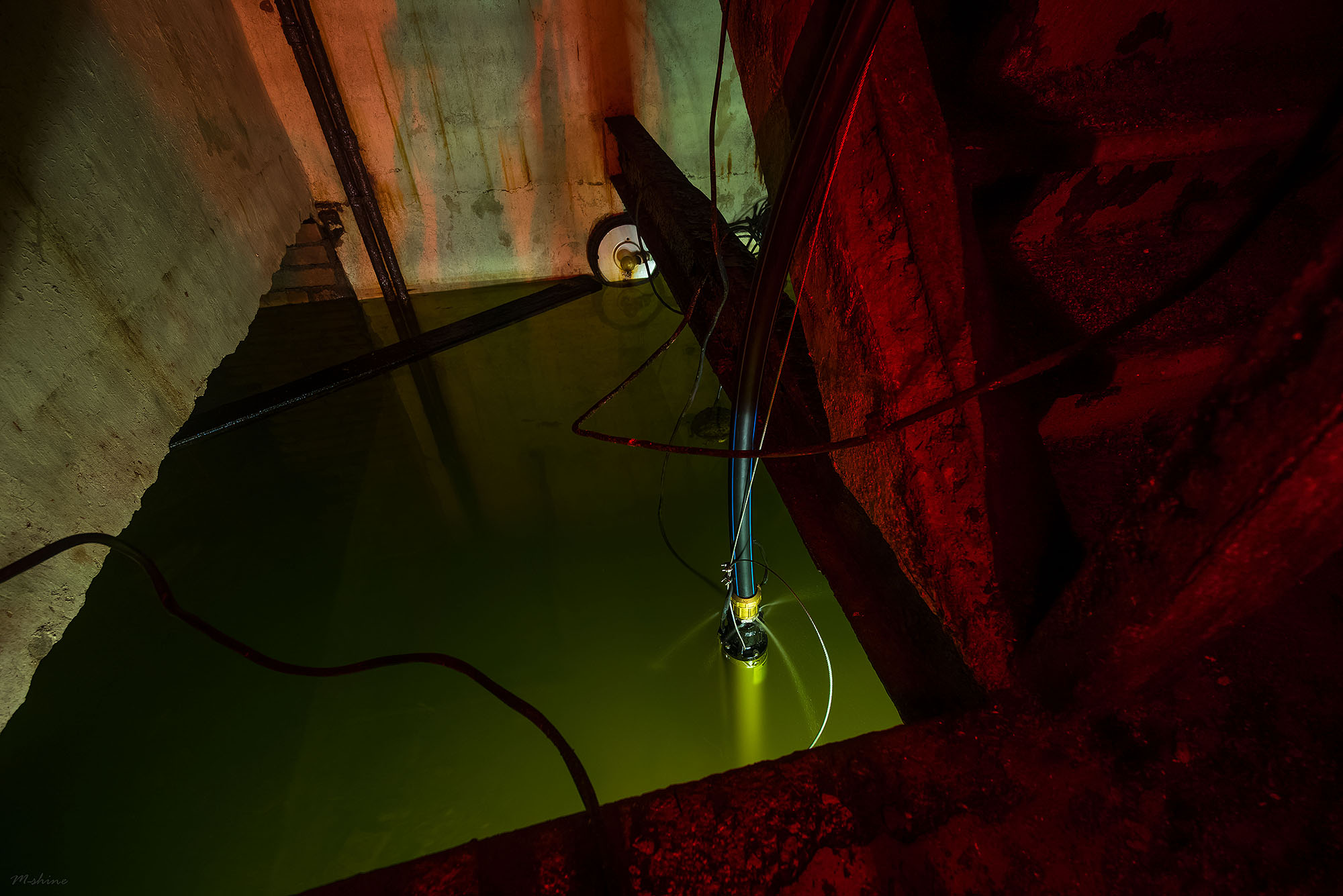

At the bottom of the trunk, the handrails of the stairs one level below become visible.

Electricity was kindly provided by the observatory itself. The fact is that a human walker leads from the very top of the barrel to the observatory building, which ends with a hatch in the floor of one of the rooms of the GAISH building. It was in this room that we connected to one of the sockets.
Bottom view of the hatch:


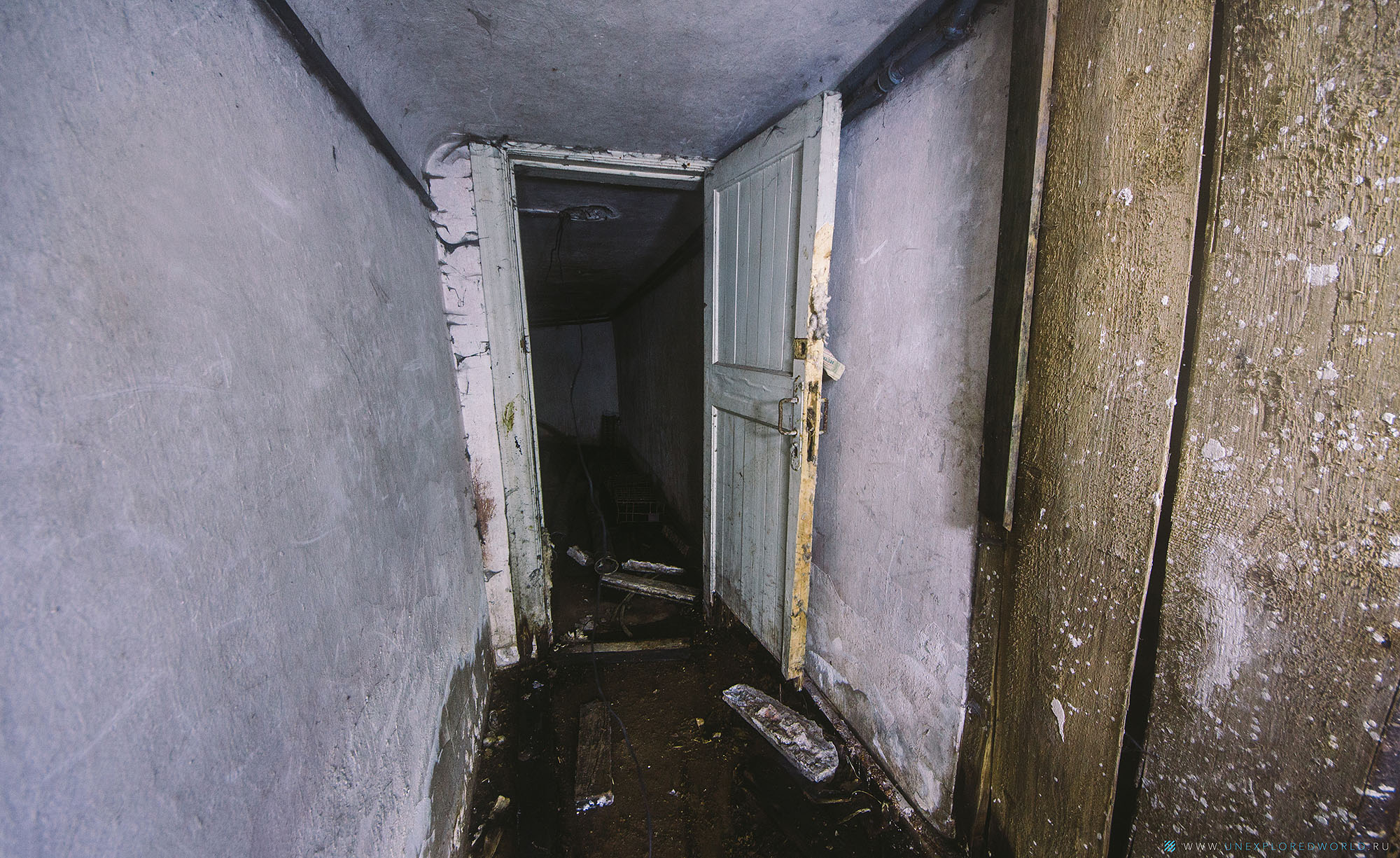

As it was written earlier, it became very comfortable with the light. And since 2 floodlights of 1000W each were used for illumination (and such floodlights are fried), the premises of the mine warmed up very quickly.
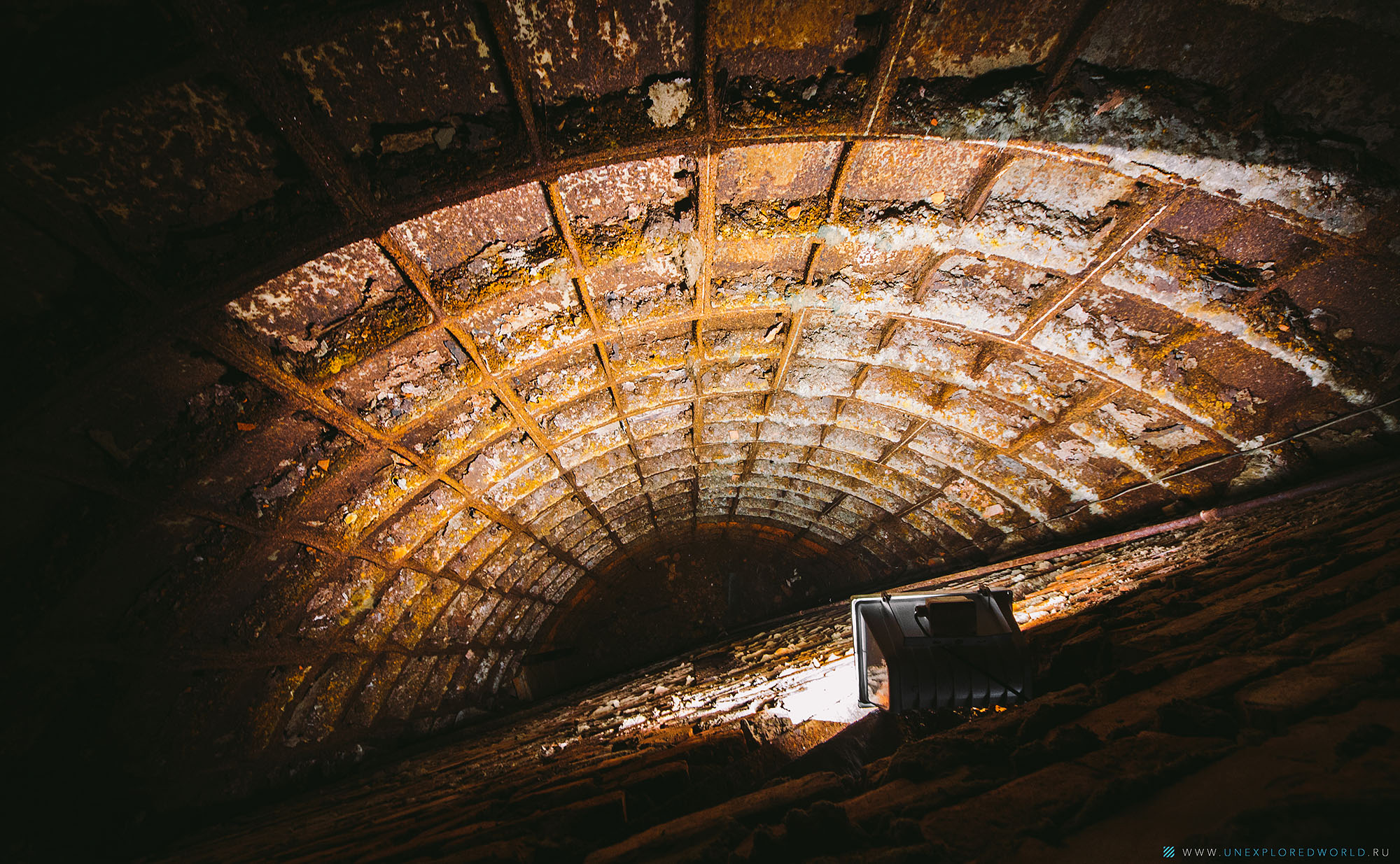
The pumping station, which, from a purely technical point of view, was supposed to do the work that we took on. But the workers of the Moscow State University were all going on somewhere.
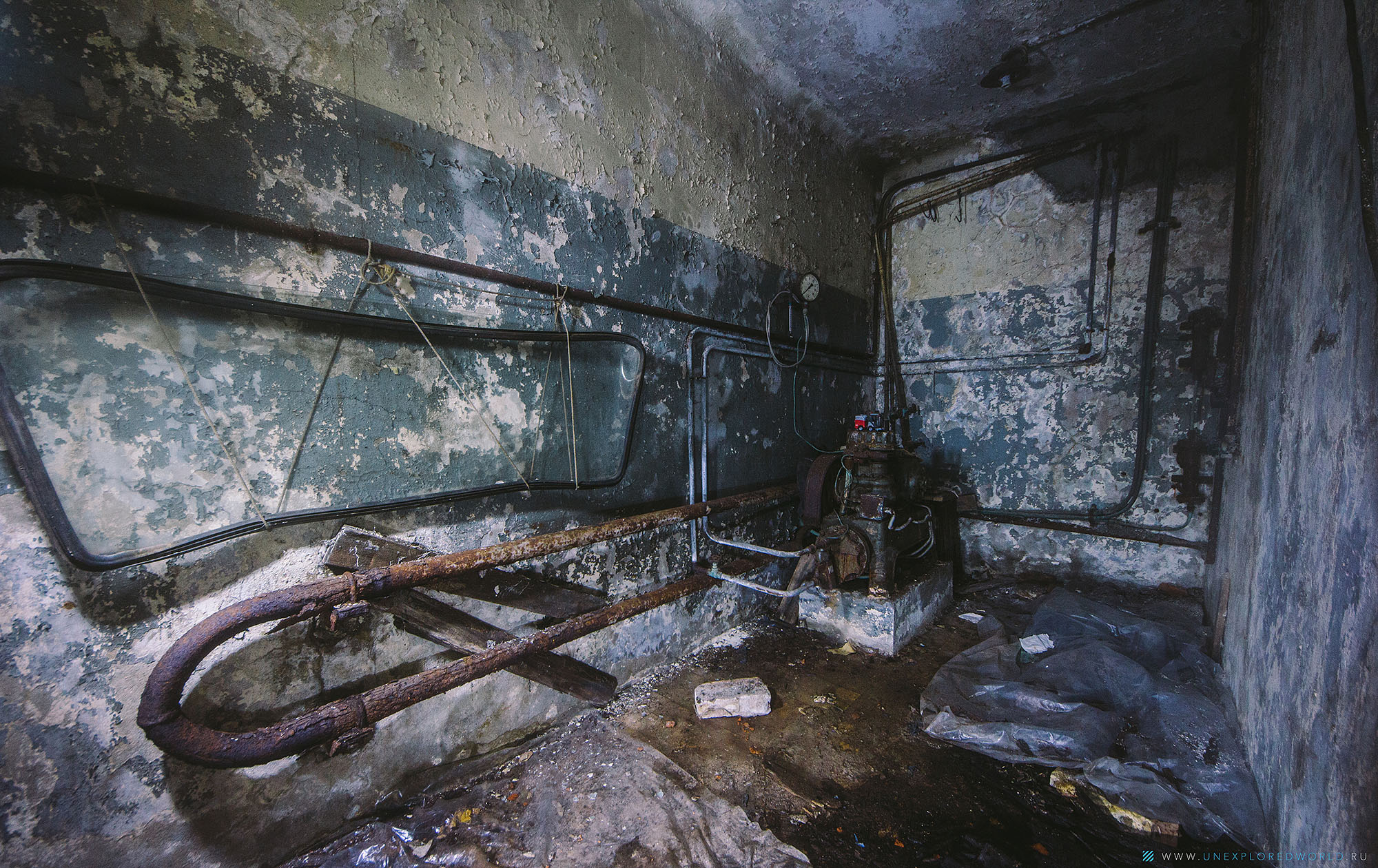
Night 2.
Meeting at midnight. With the experience of last night, everything goes several times more organized. Since the equipment has already been installed, all the work is reduced to lowering the pump a little deeper once an hour.

You can afford the luxury of playing cards:

It was this night that gave the participants in the operation the most inspiration, since both teams were permeated with the expectation of when the pump would expose the hatch from the water? Closer to morning, this moment came.
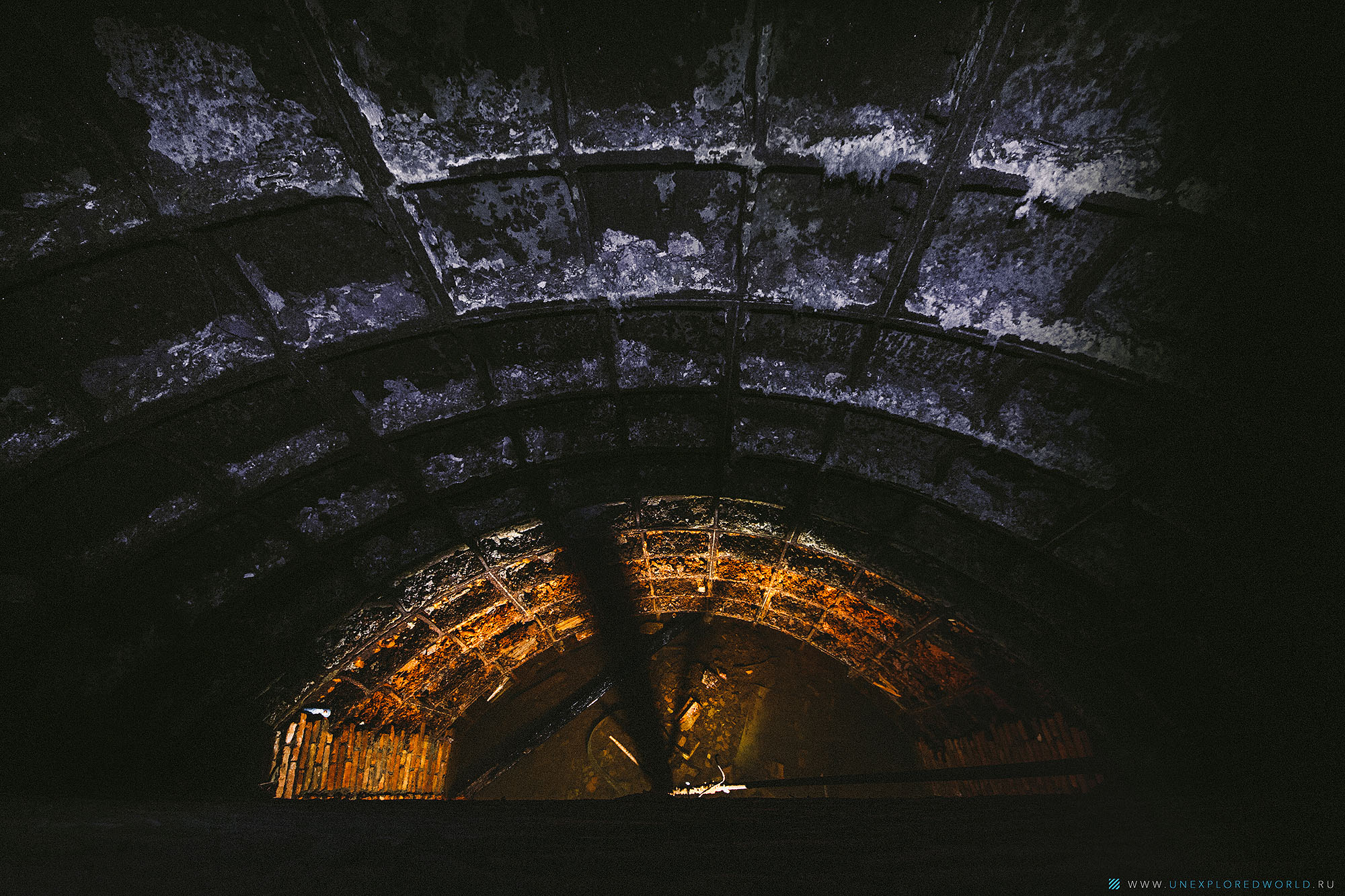
During the next movement of the pump a little deeper, it periodically began to kick out the hose. All this was accompanied by the emotional screams of the team members, as well as infernal fountains from the pump and from the hose.

The atmosphere at the bottom of the pumped out shaft was fantastic. You are left alone with the feeling of the "grandeur" of the once built structures. You feel proud of Soviet science. Where is everyone now? - Come on, we are disingenuous. In fact, in this mine, at one time, the need for its use simply disappeared, as new ways of studying what was studied here appeared. But more on that later.

We return the hose to its place and finish exposing the floor:




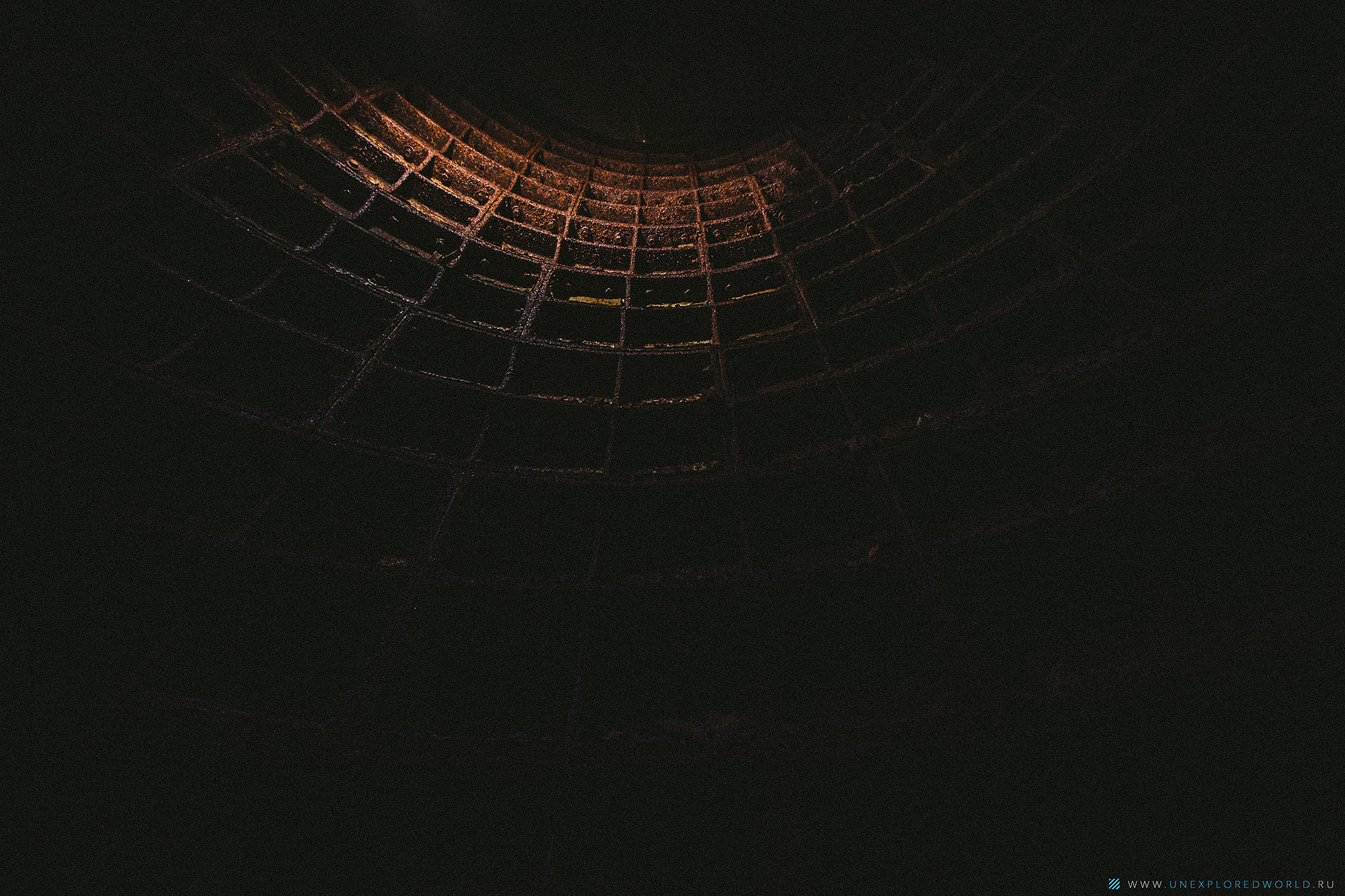
Last steps:


When all the water was pumped out, everyone, even those who were on the surface and monitored the situation, gathered in a circle at the hatch at the bottom of the barrel. It turned out to be not as easy to lift it as it was originally supposed. Rather, it was assumed that it would not be easy, but in fact it turned out to be generally hardly feasible. The fact is that the hatch had two handles, and one fell off when the scuba diver pulled it, and the second was clearly not enough to lift the hatch.

We put a crowbar into a small gap between the hatch and the base, and tried to create a lever in such a way that the hatch cover would go up. After about 5 minutes, she began to succumb slowly. And then everyone was dumbfounded: the thickness of the hatch was about half a meter! No one has seen such thick hatches even in the structures of the ZSGO. It was not wooden, but massive metal and, on top of that, completely rusted.

As soon as we managed to open and block the hatch, we immediately mounted the pump inside.

After the half-victory triumph, both teams took a photo for memory and began to gather, because it was already 5 am on the clock, which means that soon the building above us will "come to life".

Night 3.
We return to the very bottom of the trunk, where the mounted searchlights and a pump are already waiting for us. All you need to do is get out into the building and plug the plug into the outlet. While one of the participants in the process is doing this, others can afford to take some pictures.

We go down ...

Smoke break:
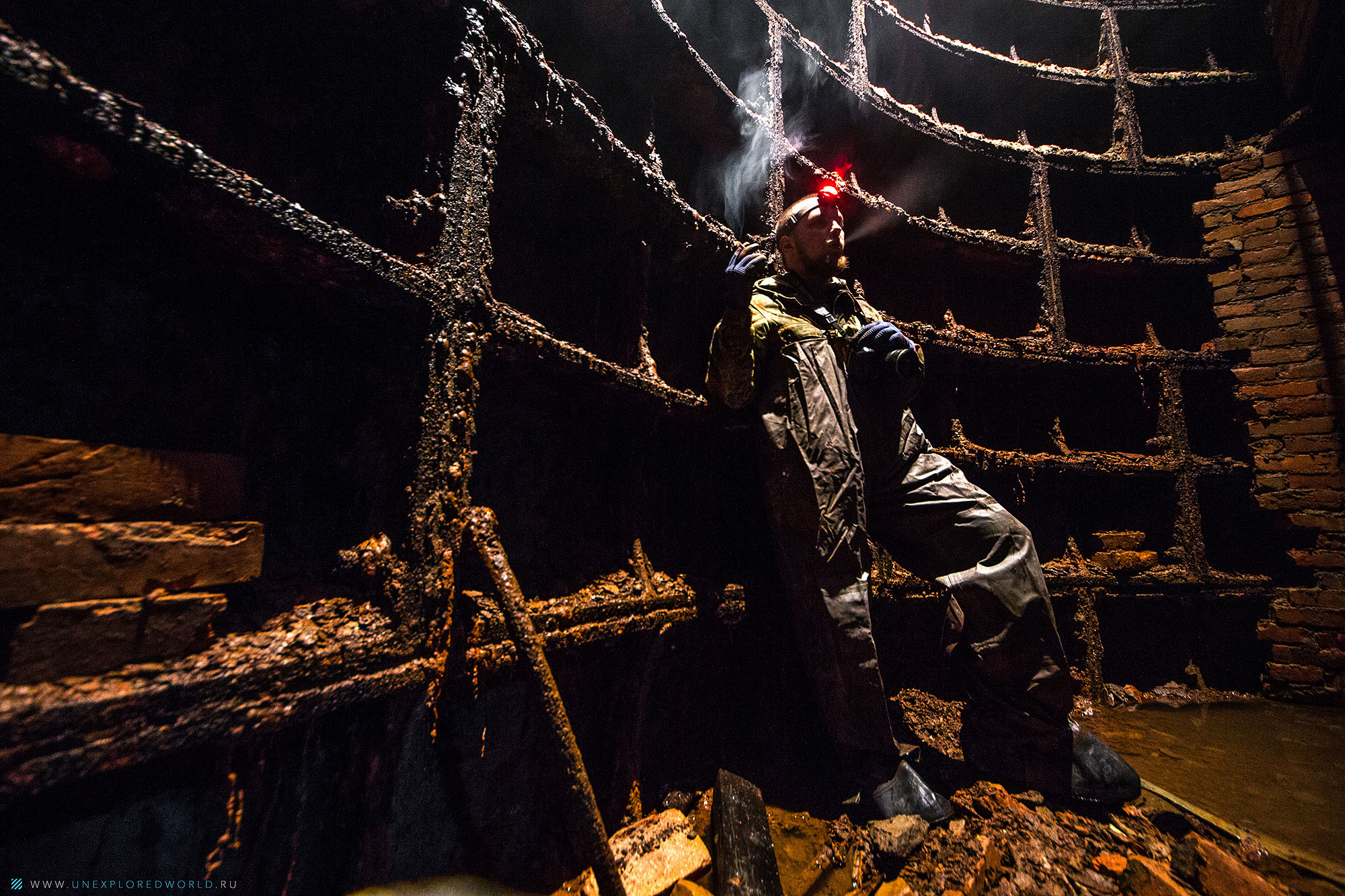
And get to work!
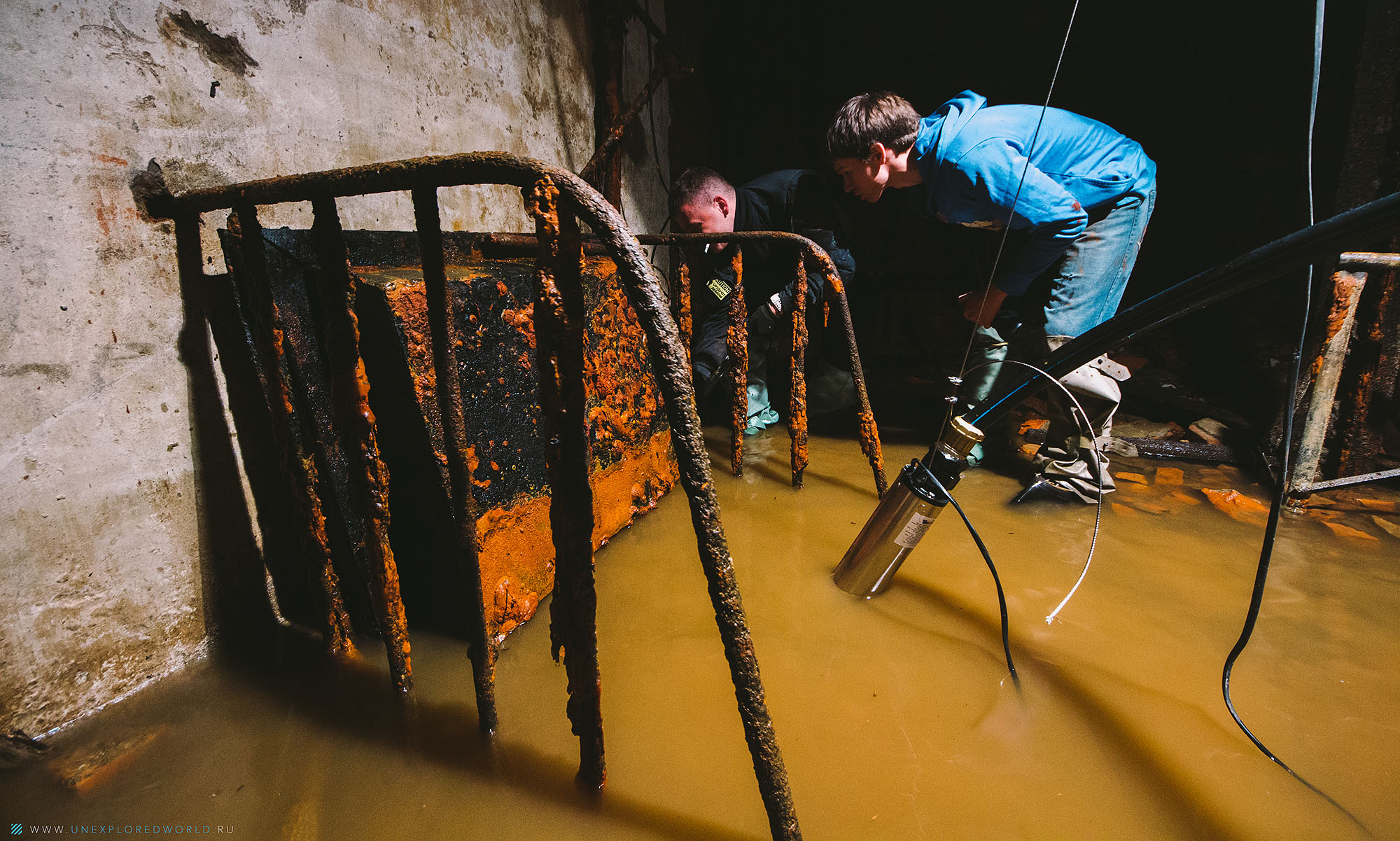

Very soon, all the water on the floor went inside the hatch, and at the bottom of the trunk it became possible to move without boots.

And after a while, the floor was completely dry.

It was the third night that promised to give an answer to the question of what scale the object at the bottom of the mine was. Since we have pumped out the entire trunk, the remaining water will decrease in direct proportion to the size of the room. And what was our disappointment when we realized that the pumping process accelerated!
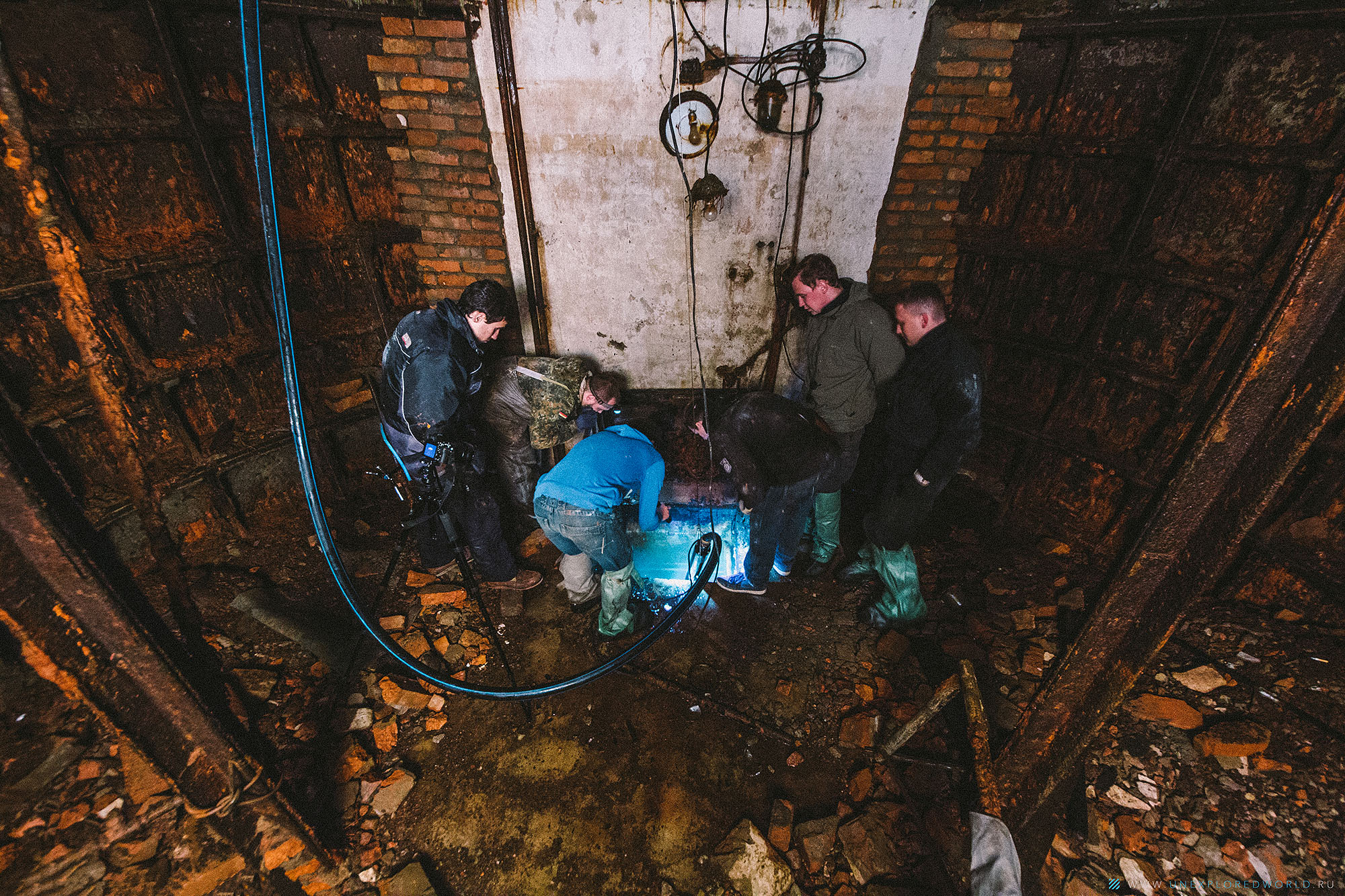
The "culprit" of the occasion was also discovered: a crack in the wall of the room, from which groundwater gradually seeped into the object. Although it is unlikely that she alone can be called the "culprit", because groundwater tends to seep from everywhere.
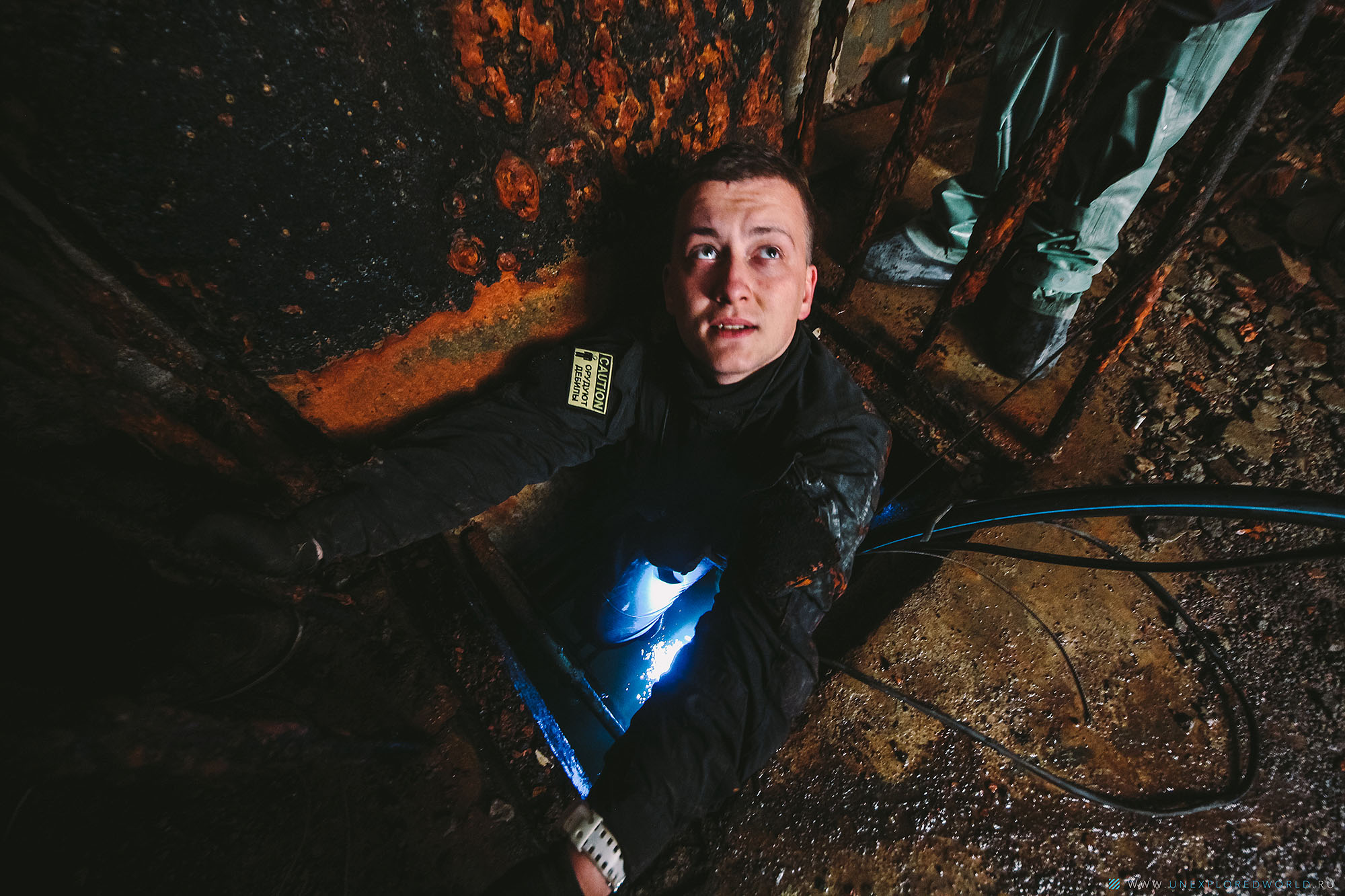
It was decided to pump it out to the end. In everyone's soul, there was still a hope of seeing something more than a tiny empty room. What if there is another hatch at the bottom of the room? But with every hour spent next to the pump, it became more obvious: there was nothing below.

Meeting:



After all the work done, when the result was already known, the inspiration that stimulates everyone has exhausted itself. 3 sleepless nights made themselves felt. There was no longer a glint in the eyes, there was only an all-embracing fatigue.
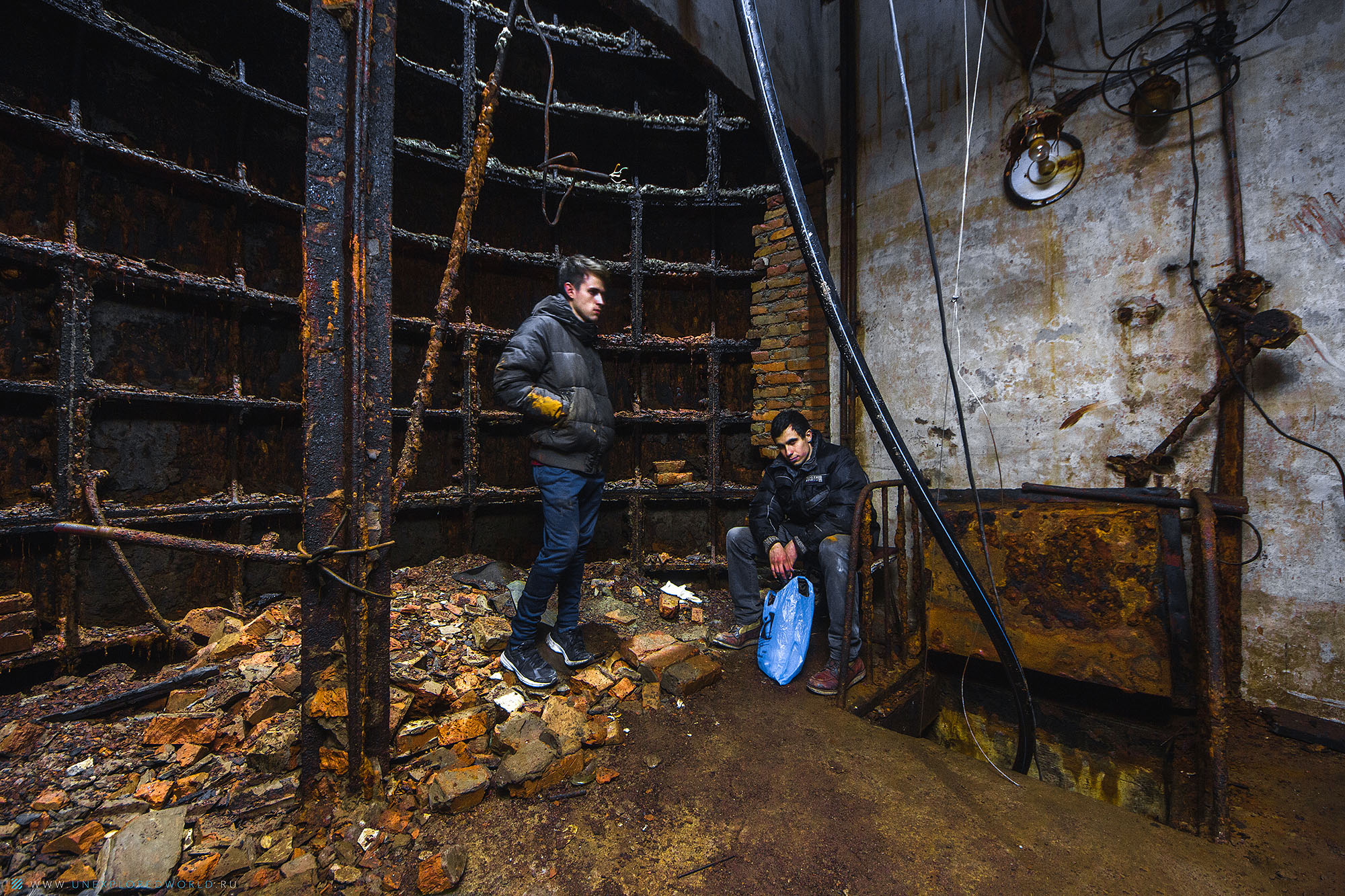
However, the atmosphere of the dungeon still inspired a certain sense of excitement.

Well, it's time to go down!

Photo with the pump not yet removed. It remains to pump out about a meter of depth from the floor.

And a completely evacuated room. All the walls in the room are tiled, perhaps with some scientific interest, or simply for decorative purposes. There are two holes on the floor: one for installing the equipment, the other for drainage. The latter apparently failed to handle 90,000 liters of water. The room is almost completely empty.

The only thing that was in this room of things: a broom, which stood under water for about 50 years. Just think about it! Fifty years under water right under the cradle of Russian science. So what kind of room is this?
From the information that we managed to find before pumping out:
In 1954, the construction of the building of the State Astronomical Institute named after V.I. P.K.Shtenberg (GAISh), consisting of a main three-story building with four towers, seven separate pavilions and clock cellar.
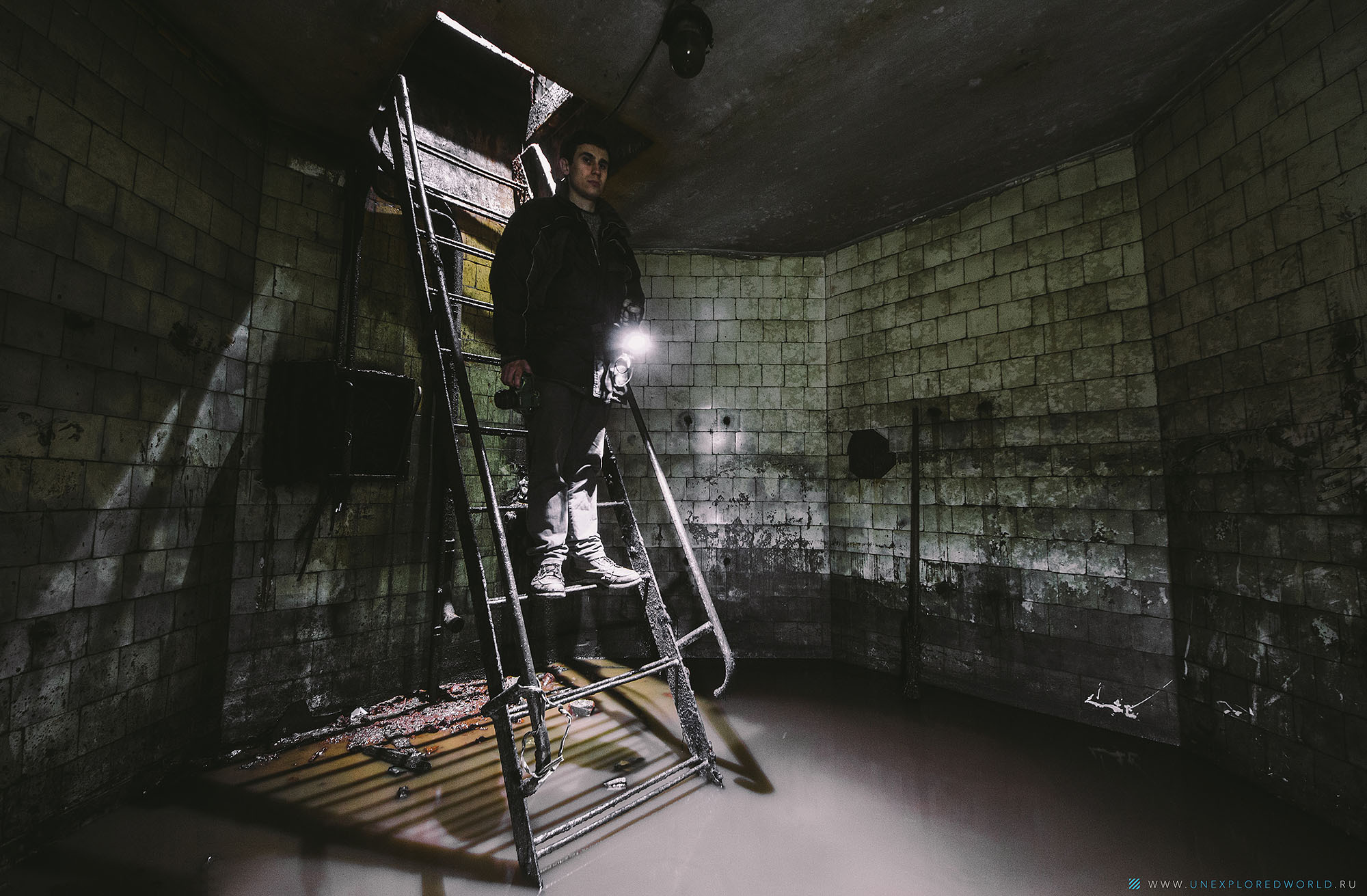
To finally confirm their guesses regarding the purpose of these mines, our team went to the observatory building and interviewed one of its employees, whose name we will not disclose, in order to avoid possible misunderstandings. He told us that this complex was called the "watch basement of Moscow State University", and at one time they were engaged in "refinement" of the standard of time, namely, they made astronomical corrections in units of time. According to the data provided from the watch cellar of Moscow State University, even the time on the Kremlin chimes was corrected in its own years! For more information on the interview, as well as how exactly the pumping of water from the mine took place, you can find out in our film. Do not be lazy to master these 40 minutes, this story is worth seeing! The film will be published at the end of this article.

That's all! This is what the end looks like. Even though we did not find anything large-scale below, it was work for the sake of work, not for the sake of victory. Everyone was happy. We did it. We not only touched the history of the place, but created a new history for this place!

However, the end of pumping does not mean the end of the post. New life was literally breathed into this place. At first, scientific research was carried out in it. During the collapse of the USSR, bags of food were secretly stored. And now it has opened for itself a new page in history, and accepts us: adventurers, seekers of the unknown! Handle it with care, so that someday, perhaps, when we no longer find it, something epochal new will happen there.
Now that there is no more water in the barrel, you can take fundamentally new pictures that were previously impossible to take. For example, sit on the floor. The water surface, if you look at the photo below, was at the level of the light bulb.

Or stand up and look upward:
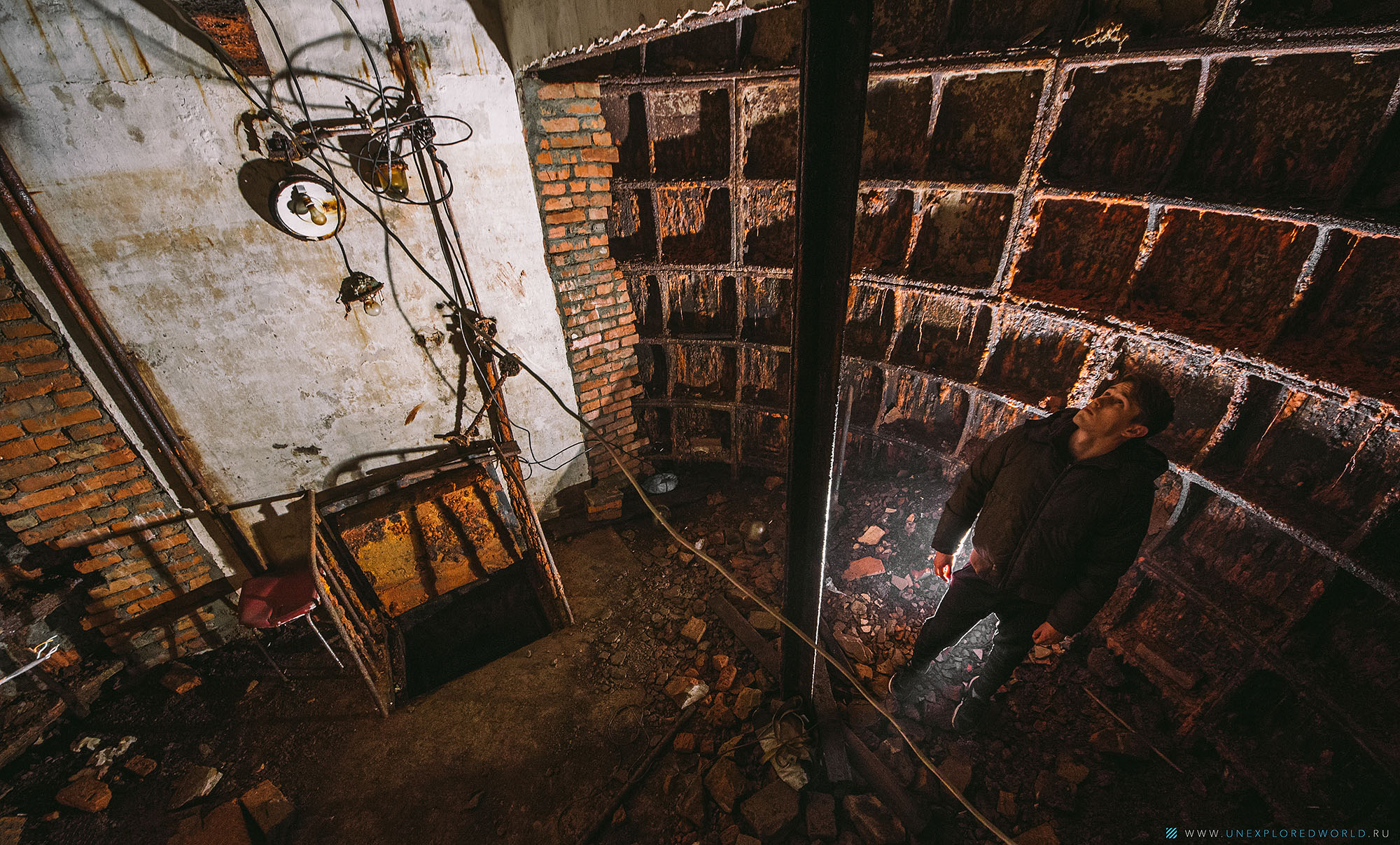
Or take such pictures from the bottom up. Previously, they could not be removed either.
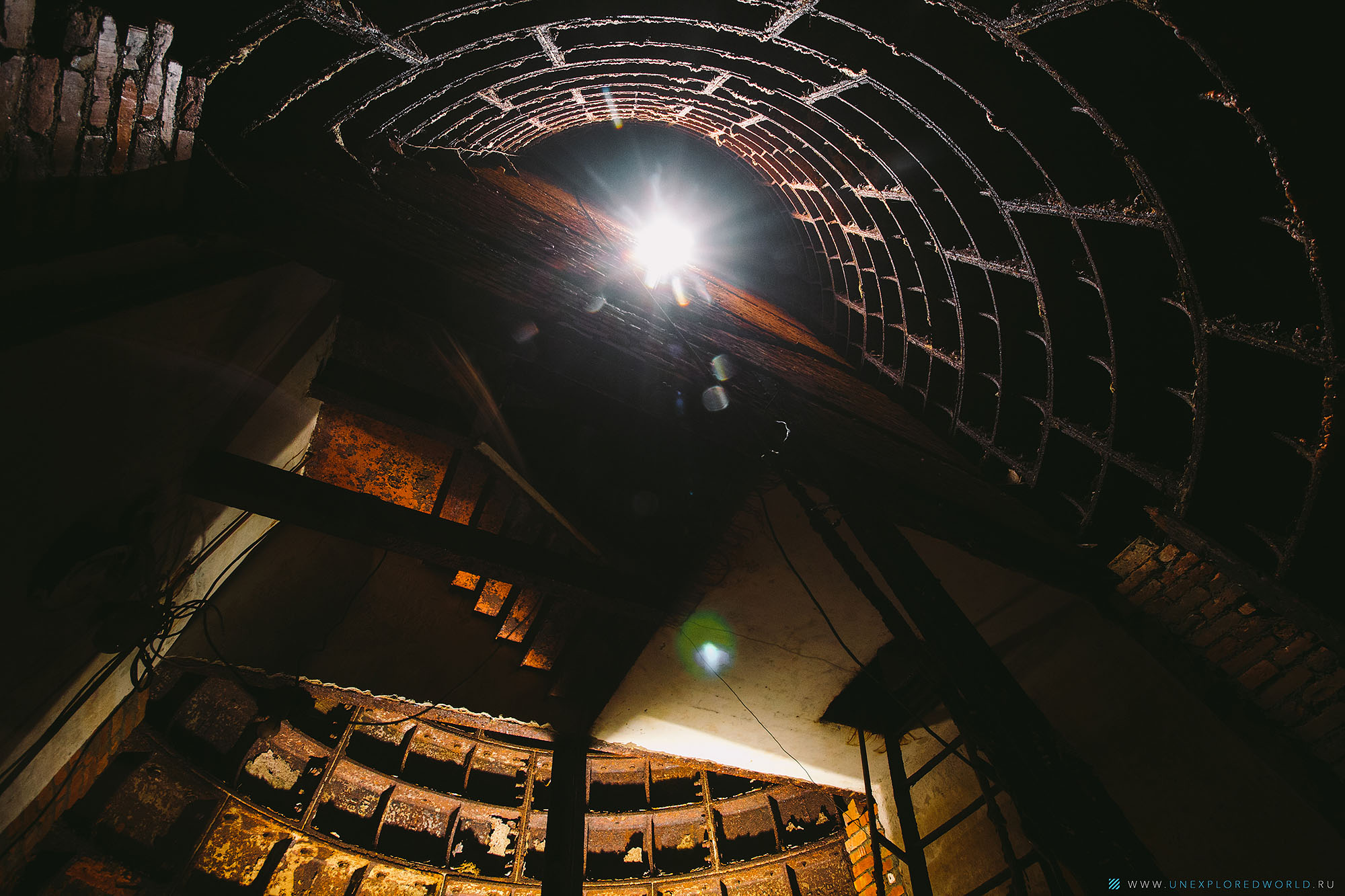




Small bonus: Panoramas taken during the pumping process:

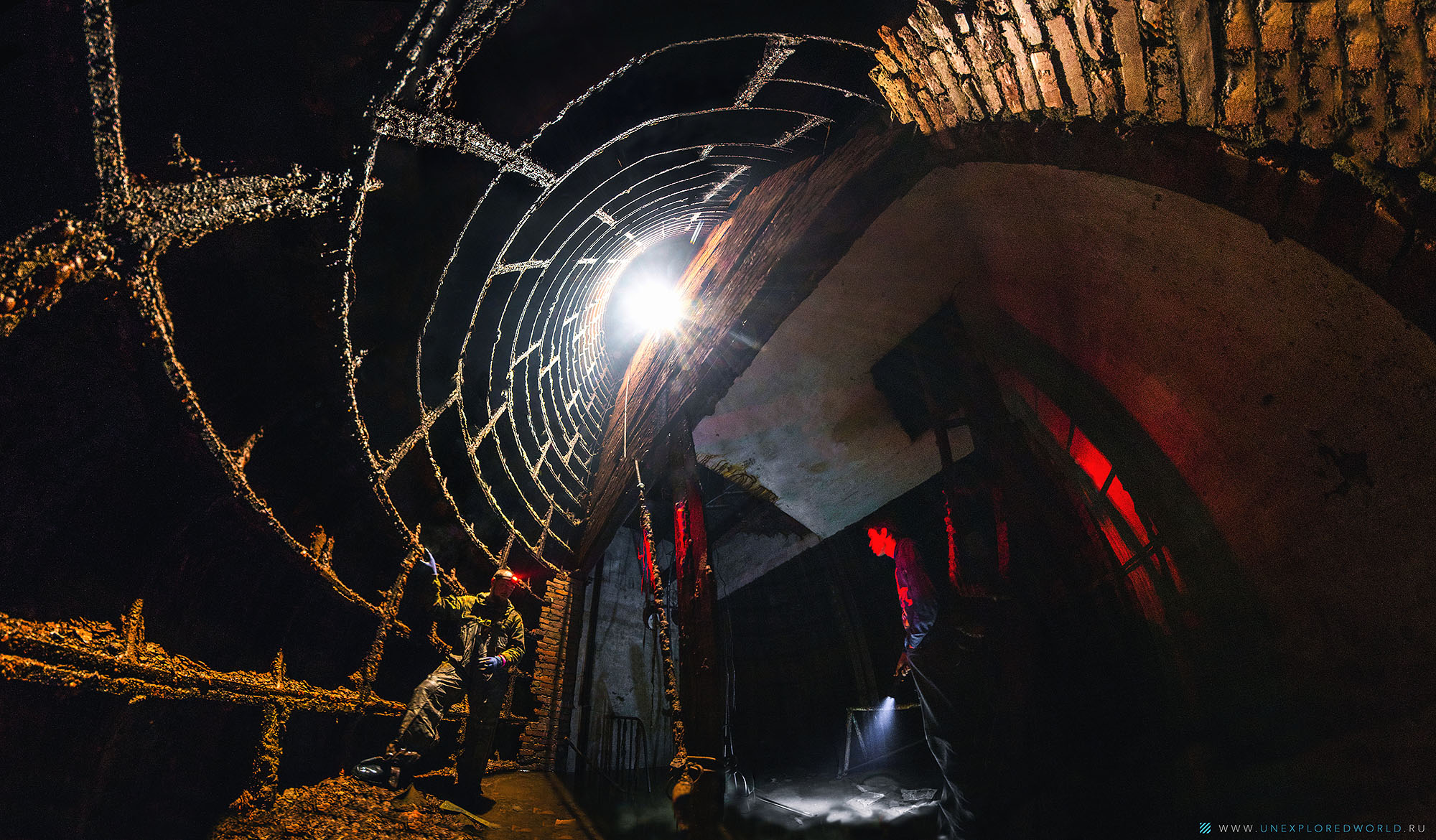

And a big bonus: (very large!) you can enjoy a virtual panorama right from the bottom of the mine shaft! Just click on the image below. (you can change the view of the panorama: stereographic, fisheye, etc., and you can also scale and examine even the smallest details).
And a very FAT bonus, the movie:
That's all. I would like to thank everyone who mastered the text and video written above.
For the provided part of the photos, I would like to express my gratitude to Artem A.
PS The most savvy lovers of the unknown have probably already found two pavilions of the time service of a very suspicious form on the territory of the Pulkovo Observatory (this is the one in Pulkovo). We want to tell you that there is no need to climb there, there is nothing interesting, and even more so, a 150-meter underground block at a depth of 34 meters. Honestly.

3 Responses
Thanks guys for the material! Do everything at the level! Success
you did a good job. and the electricity bill at Moscow State University has not increased too much?